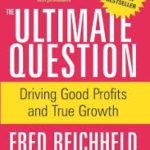The murky world of customer feedback
In this third article, we’re going to look in more detail about Net Promoter Score (NPS) and its history. Predominantly because in my experience it seems to produce the marmite effect on both people and organisations in that it’s either really liked or really hated. Let’s look at the back ground and explore why it produces the reaction it does.
NPS was the brain child of Fred Reichheld, the business author, strategist and Harvard Business School MBA holder. NPS was first documented in his Harvard Business review published in 2003, entitled ‘The one number you need to grow’ having already published two books around the subject of customer loyalty; The Loyalty Effect (1996) and Loyalty Rules! (2001). In 2006 he went on to publish The Ultimate Question and in 2011 published The Ultimate Question 2.0.
Where did Net Promoter Start?
Frustrated by the apparent confusion, ambiguity and lack of insight from current customer research and the ability to clearly correlate that to company growth, Reichheld, conducted research over a two year period on large U.S organisations. His aim was to try and determine the relationship between customer survey responses, consumer behaviour and company growth in order to be able to predict under a set of conditions, how successful an organisation would be in the future based on its ability to satisfy the needs its customers.
 Reichheld had argued for a long time, that the key driver of business growth was customer loyalty and from his research he went on to argue that in order to determine the link to growth, you only need to ask customers how likely they would be to recommend, and only that. His research suggested that this single question was the strongest predictor of future success of an organisation and was correlated strongly to financial performance. The blue touch paper was lit and Fred Reichheld became an overnight global ‘saviour’ of the business world as did NPS. In 2003, Consulting Magazine named him one of the world’s top 25 consultants.
Reichheld had argued for a long time, that the key driver of business growth was customer loyalty and from his research he went on to argue that in order to determine the link to growth, you only need to ask customers how likely they would be to recommend, and only that. His research suggested that this single question was the strongest predictor of future success of an organisation and was correlated strongly to financial performance. The blue touch paper was lit and Fred Reichheld became an overnight global ‘saviour’ of the business world as did NPS. In 2003, Consulting Magazine named him one of the world’s top 25 consultants.
The spread of NPS
Use of NPS spread like wild fire and it was quickly adopted by business goliaths like General Electric, Philips and American Express. Boardrooms liked it because of its simplicity. It was one question, it was easy to understand and it provided an instant barometer or pulse on the health of customer loyalty and as such, the future financial performance of an organisation.
However, NPS quickly became an obsession for most with the results themselves being the end game rather than driving actions to improve the customer experience. I’ve witnessed first-hand the voracious boardroom appetite for the next NPS score upon which hangs an impending witch hunt or extreme celebration depending on the outcome. In fairness this effect isn’t solely the result of NPS itself but it has contributed to a boardroom perspective that this one question is indeed a ‘silver bullet’ in both measurement and understanding.
Does NPS work?
However, like any good piece of research, the results should be replicable and over the following years, researchers and academics tried to reproduce Reichheld’s results to either validate or refute the one number approach. Two studies, one in 2007 and latterly in 2008 by Bob Hayes of Business over Broadway cast doubt on Reichheld’s original research and went as far to say there was little or no correlation between the results from the likelihood to recommend question and business growth.
They even pointed to flaws in the original research data and the methodology used. There was no dispute about the link between loyalty and growth however. The subsequent research put forward that the one number approach was no more useful than other indicators like customer satisfaction. However, by that point it was too late and the NPS industry had been borne. NPS itself is now trademarked and you can now become a certified NPS practitioner through a training course with Satmetrix, the NPS software tool company.
NPS has a place and there’s no dispute with that. However it falls short of being the silver bullet solution it was touted to be which is where some people lost interest. The results of the measure itself provide a snap shot in time which can be a useful indicator but only that. When used in isolation, it lacks the granularity and the ability to explain ‘why’ a particular result is as it is. In this situation, further research is required which could have been done initially saving both time and money.
Benchmarking
Using NPS, as using customer satisfaction, allows for benchmarking both across and within industries and Satmetrix offer NPS benchmarking as does The Institute of Customer Service for Customer Satisfaction. However using NPS as an overall indicator, due to the way it’s calculated is much more volatile than say a weighted index and so results tend to fluctuate more over time which produces similar waves in the boardroom which is not always useful when trying to drive consistent approach and messages to customer experience improvements.
In addition, what research has continued to prove is that customers rarely behave in a rational way especially in relation to what they say they’ll do versus what they actually do. Just because customers say they’ll recommend, doesn’t guarantee that they actually will and again research continues to bears this disconnect out.
What NPS is though is another tool in the tool box for helping people and businesses understand customers better and that’s always a positive. As with many types of measurement, being aware of the limitations as well as the advantages allows for more effective and meaningful use that benefits everyone.


